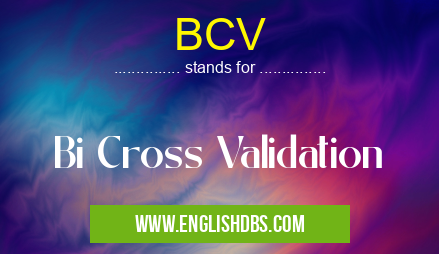What does BCV mean in UNCLASSIFIED
BCV stands for Bi Cross Validation. It is a resampling technique used in machine learning to evaluate the performance of a model. It is a more rigorous and reliable method than traditional cross-validation and provides a more accurate estimate of the model's generalization error.

BCV meaning in Unclassified in Miscellaneous
BCV mostly used in an acronym Unclassified in Category Miscellaneous that means Bi Cross Validation
Shorthand: BCV,
Full Form: Bi Cross Validation
For more information of "Bi Cross Validation", see the section below.
BCV Methodology
BCV involves iteratively splitting the dataset into two subsets: a training set and a validation set. The training set is used to train the model, while the validation set is used to evaluate its performance. The process is repeated several times, with the training and validation sets swapped in each iteration.
Advantages of BCV
- Reduces Overfitting: By using two different sets for training and validation, BCV helps prevent overfitting, which occurs when a model performs well on the training data but poorly on new data.
- Provides Unbiased Estimates: BCV provides unbiased estimates of the model's performance because it involves multiple iterations and uses different subsets of the data.
- Improves Robustness: It enhances the robustness of the model by ensuring that it generalizes well to unseen data.
Essential Questions and Answers on Bi Cross Validation in "MISCELLANEOUS»UNFILED"
What is Bi Cross Validation (BCV)?
Bi Cross Validation (BCV) is a technique used in machine learning to evaluate the performance of a model by splitting the dataset into two parts: a training set and a test set, and then repeating the process multiple times.
What is the purpose of BCV?
The purpose of BCV is to provide a more robust estimate of a model's performance by reducing the impact of any particular split of the data. BCV also helps identify potential biases in the model and ensures that the evaluation is reliable.
How does BCV work?
BCV involves splitting the dataset into two parts (training and test) multiple times. For each split, a model is trained on the training set and evaluated on the test set. The performance of the model is then averaged across all the splits to provide a more robust estimate.
What are the benefits of using BCV?
BCV offers several benefits, including:
- Reduces the impact of data split on model evaluation
- Provides a more robust estimate of model performance
- Helps identify potential biases in the model
- Ensures the evaluation is reliable
When should BCV be used?
BCV is particularly useful when dealing with small datasets or when the data distribution is skewed. It can also be beneficial when evaluating models that are sensitive to the data split.
Final Words: BCV is a powerful resampling technique that provides a more accurate and reliable evaluation of a model's performance. It is particularly useful for complex models that are prone to overfitting. By reducing overfitting, improving robustness, and providing unbiased estimates, BCV helps ensure that the model is well-suited for real-world applications.
BCV also stands for: |
|
| All stands for BCV |
